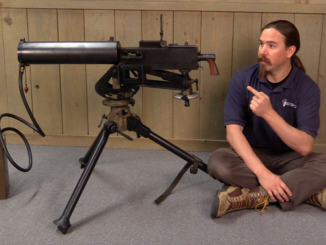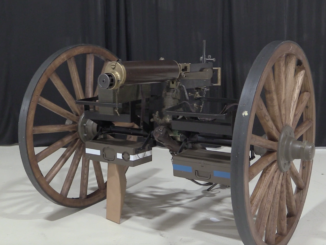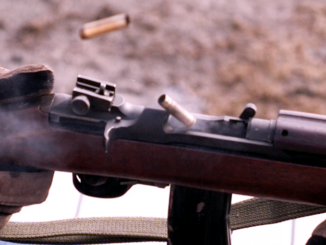When the US entered WWII, submachine guns were in short supply and high demand. Much of the production of Thompson guns was being purchased by the UK, and what guns were available to the US military went first to the Army. In accordance with long tradition, the Marine Corps were secondary to the Army in receiving new weapons. However, the formation of a Marine paratroop unit in particular necessitated the Corps finding some sort of suitable submachine gun.
What was available at the time were Eugene Reising’s M50 and M55 guns, being manufactured by Harrington & Richardson. The guns were chambered for the standard .45ACP cartridge and used a delayed blowback action which allowed them to be significantly lighter than the Thompson. The M50 had a full-length traditional stock, while the M55 used a pistol grip and wire folding stock. Mechanically, the two variants were identical. The M55, which is what we have today, would up being specifically issued to tank crews and paratroops, where its compactness was a significant advantage.
The Reising developed a quite bad reputation in the Pacific for a couple reasons. Its parts were not always interchangeable between guns (a deliberate choice to speed up manufacture, which troops were not necessarily aware of), its mechanism was more susceptible to fouling than other military small arms, and its disassembly procedure was far too complex for military service. However, these issues did not prevent it from being quite successful and well-liked as a law enforcement weapon in civilian police use after the war. Thanks to that negative wartime reputation, Reisings are some of the least expensive military machine guns available on the market today in the US.




Can you derive the actual full auto rate of fire from the slow motion video?
Says 550 max https://en.m.wikipedia.org/wiki/M50_Reising on that, but it seems faster than a big Uzi albeit in a different calibre but it’s lighter than one seemingly… Maybe it’s movement as a consequence of the two factors aforesaid makes it seem higher, the author mentioned 800 I was going to say it looks a higher cyclic rate than a Uzi- Big one at 600rpm, thought 700+ via watching videos, the Ppsh sounds much faster and it was apparently.
Ian,
Thanks for continuing to present very articulate videos on equally very cool firearms.
It was my pleasure to contribute to your expenses via Patreon!
Steve in Prescott Valley
Easily, hands-down, the most informative video I’ve seen on the Reising. There is the very famous Pacific War photo of Navajo/Diné code talkers where at least one of the team has a Reising .45.
Question: There was also a Harrington & Richardson Reising semi-auto version with a full stock… I wan’t to say the M65, but I’m not sure about the nomenclature. Apparently it was issued to factory guards and watchmen and so on during the war. The barrel is still short. Is that version an NFA sbr, or is it under some kind of C&R status in spite of the barrel length?
One can definitely see the appeal for LEOs vs. a traditional shotgun.
2Dave Carlson
It was the M60
Reising M60 semi-automatic carbines were used by the Ohio State Department of Corrections as tower guard guns at the Marion, Mansfield and Columbus, OH, prisons, and the London, OH, prison farm. They were purchased from the manufacturer by the state in 1938, and were used until being retired in 1978 (replaced by the Ruger Mini-14 in .223).
After retirement, they were sold to used gun jobbers, notably Buckeye State Guns, and most ended up sold by stocking dealers.
They required no special license or tax stamp because they had 16.5″ barrels, not including the 2.5″ muzzle compensator. Note that not all M60s have this compensator. Keep in mind that the design came after the NFA 1934, hence that extra half-inch of barrel to qualify it as a semi-auto rifle, legally, in spite of its pistol caliber.
The M60 normally came with a 20-shot magazine, and was rated for use with standard 230-grain FMJ ammunition (standard or Match grade).
Back then, a clean M60 (they were well cared for)could be picked up for about $200. Later on, Marlin made their semi-auto carbine in .45 ACP on about the same principle.
Neither one sold very well around here. Buckeyes generally hold that a rifle-sized, rifle-weight, rifle-type weapon ought to fire an actual rifle cartridge. Things like 9mm Uzi “carbines” were never big sellers around OH, either.
AK clones have always been popular. An SMG-sized arm that hits about like a low-end .30-30 WCF seems about right to most Ohio shooters.
For pistol-caliber shooting we tend to use…pistols.
😉
cheers
eon
Ian, some point in the narration part you say that part of the Reising’s unpopularity was “because it was a delayed blowback gun”. Well, I’ll beg to remind anyone, that so was the Thompson until the advent of the M1 and M1A1, putting it in the straight blowback club thereafter.
The 1st Marine Raiders were definitely not the best admirers of the Reising, in fact it was the Rangers who started the black legend of the Reising by slinging their own ones into the crocodile-infested waters of the Lunga River after the Guadalcanal campaign by the orders of their chieftain, Red Mike Edson.
Of the famous Reising users, the M55s are also seen in several of the rare period photos of the USMC Navajo code talkers – even though in the movie ‘Windtalkers’ all you can see are Thompsons galore.
IIRC the semi version was the Model 60.
The Canadian Army in Canada was issued Reisings in WW2.
The action bar, seems a waste of materials… In a blowback, military design.
It’s snag free, but like…
There is a war on.
It is the mass of the action bar that provides a good part of the delay.
The bolt sliding in the recess in the roof of the receiver, has to cam the action bar back out of the way, via the sloped cams before it can drop.
The cams accelerate the action bar, and multiply the apparent strength of the recoil and mainsprings.
Note, it depends on angles and inertia, not friction.
It’s all very clever. With more thought to the other parts of the gun, the ideas might still have merit. esp for something like a .30 carbine class round, or perhaps even bigger.
It certainly looks easier to cut straight cams than say a de Kiraly accelerator lever, or Mauser/CETME roller seats
Ah…
At instant of firing, the small breechbolt, through the support of camming action bar and locked in recess inside the receiver, uses all the mass of the weapon to stand against to the recoil force generated by the fired round instead of sole mass of recoiling parts being common in the usual blowback. The brechbolt transmits sufficient amount of momentum to the action bar for cycling the action. Very clever approach for using powerfull rounds with small massed firearms and should be questioned why not used in the following times. IMHO.
Or, a truer statement; the recoiled gun gives the momentum for action bar to start its backward travel for delocking the small breechbolt from locking recess of receiver and the breechbolt goes backward by gained momentum and remaining gas pressure in the barrel. This concept was used partly as slightly different form in Benelli M76 pistol.
I looked at that m76, while looking at the Remington M51… Kinda of get you.
“It’s all very clever. With more thought to the other parts of the gun, the ideas might still have merit. esp for something like a .30 carbine class round, or perhaps even bigger.”
There exist successful delayed-blowback fire-arm for .30 Carbine – the San Cristóbal carbine used in Dominican Republic and designed by Pál Király (designer of Danuvia 39.M sub-machine gun).
When Reising was tasked with designed .30 carbine fire-arm he designed this:
https://www.forgottenweapons.com/wp-content/uploads/manuals/Reising%2030%20carbine.pdf
It is related to Reising sub-machine gun but it is gas-operated not delayed-blowback
Says it used a locking mechanism rather than the delaying lark, what was this mechanism do you know Daweo?
Before the gas operated Reising, the did make a delay blow back in .30 carbine. It didn’t work well so they then made the gas operated one.
Thanks! I’ve wanted to see the insides of the Reising for a long time. It’s really quite clever, one of the great “might have beens” of the war. You have to wonder what would have happened if they’d had more time to test and identify the problems and fix them before actually fielding the guns. The Reisings had the misfortune of being sent to possibly the worst possible environments in the world for firearms. If they’d been used in Europe their reputation might have been much better. Especially if they’d spent a little more time and produced a better folding stock.
Mini me, style stock… “Can’t say I thought of that style, before I saw it mind” would have been alright.
Well they sort of got used in Europe….there is a photo of a Reising equipped American Marine guarding German D-Day prisoners on the quarterdeck of the USS Texas.
7.62x33mm might have been better, it does have a delaying mechanism.
Thanks for another excellent explanation.
A gun that might have had huge potential.
Re the stock, so that’s where Bubba spent WWII!
I’ve seen an M50 Reising in Soviet Hands before.
“its mechanism was more susceptible to fouling than other military small arms, and its disassembly procedure was far too complex for military service.”
Notice that Eugene Reising was according to https://en.wikipedia.org/wiki/Eugene_Reising “ranking competitive target shooter” so he has good experience with target fire-arms, so I assume that (less or more intentionally) he used solutions good for this purpose.
Notice that most Russian/Soviet fire-arms designer has low rank military rank when they designed their fire-arms or were machinists/former machinists or army gunsmiths/former gunsmiths, examples:
G.S.Sphagin (designer of PPSh, SPSh flare pistol, co-designer of DShK) was gunsmith and later, after 1920, machinist at Kovrov plant
M.T.Kalashnikov (designer of PK machine gun and other) was Sergeant (Старший сержант) and tank commander in 1941, when he starts fire-arms designing
A.I.Sudayev (designer of PPS and AS-44) was machinist
F.V.Tokarev (designer of TT and SVT) was machinist
Reising also designer .22 automatic pistol,
http://americanhandgunner.com/exclusive-web-extra-the-reising-22-semi-auto-pistol/
rated The Reising .22 Semi-Auto Pistol positively
They did him under the Sulivan act eh, the rotters.
Kalashnikov worked in a railway repair depot in Kazakhstan between his escaping from political exile in Siberia and his conscription into the tank regiment.
Initially he had returned to his home village on forged papers, however the local cops had got wind that he had a pistol (death penalty if he got caught with it) so he went on the run and got a job via a friend’s brother in the locomotive works.
The draughting and machinist staff at the locomotive works, produced the drawings and prototype of his SMG, following his being injured.
Great video. I have always had a soft spot for the Reising as it was the first fully automatic weapon I ever fired. It was a M50 that belonged to a state trooper who was a friend of my father’s. It had the big muzzle brake and had been refinished in hard chrome. He kept it as a duty weapon in the early ’70s. At the time, I thought it was the most amazing thing in the world and I still grin when I remember ripping out that first burst of .45 ACP. (I was twelve.) I’ve often considered getting one for nostalgia’s sake. The prices are generally reasonable for a transferable SMG, and battlefield problems aside, it would be fun range toy and a reminder of my misspent youth.
Looking at the pictures in Sixguns by Kieth, it seems the Border Patrol used a number of them post war. Picked up a Tommy gun for the first time a couple of weeks ago, all I could think was how heavy the thing was–it doesn’t have good balance to offset the weight, the thing is just heavy. Not something that documentaries and war movies impart. Easy to see why this design was popular with people who could keep them clean.
I recall reading somewhere that they were used by guards, stateside, during the war. The Germans got away with a lot of sabotage in the prior war, and it was resolved not to let that happen again.
Regarding marine units soaking gun parts in solvent as a unit, would that not have resulted in issues with head space with 03 or M1 rifles? I can see not being able to cannibalize parts being very frustrating in the field, but I’m a little doubtful that guns were stripped and randomly re-assembled by marine units in the field (not by armorers but by individual leathernecks). I certainly wasn’t there, maybe it did happen, it just doesn’t sound right.
Coca-cola cleans Gpmg “FN” ones, bits. Mind you, everyone does it separately in the U.K maybe thats why i.e. Mixed up bits, must have been a nightmare trying to fit everything back together if they wouldn’t fit.
This sounds like it could have been an absolutely amazing submachine gun with better manufacturing.
I wonder how it compared economically to later guns like the Uzi in terms of man-hours, machine operations, and materials?
It would come up short compared to an UZI(etc). I’m short on time right now, but I have a couple of books on the Reising and they go into the details about the manufacture.
I’ll try to dig them out and give a little detail about the manufacturing process and the costs.
I got out “The Reising Submachine Gun Story”, by Frank Iannamico.
I was going to post the details on the machining of receiver, but that was even more than I thought it was. Here is the general process for the receiver. I may have gotten a couple thing out of order.
1. Bore 1.25 inch round stock.
2. Broach to 0.75 -.006 + 0.005
3. Square ends.
4. Chamfer ends.
5. Grove for action bar with special cutter.
6. Cut slot for sight.
7. Dove tail for sight.
8. Drill then tap or ream several holes with 6 spindle drill. A total of about 9 holes.
9. Ejector port countersunk.
10. Mag port countersunk.
11. Counter bore 4 holes.
12. Ejector opening cut.
13. Mag opening cut.
13. Cut cartridge entrance.
14. Slant ejection port.
15. Hand retap stud hole.
16. Ream holes for safety.
17. The 4 step process to add the studs.
18. Two broaching operations on the studs.
19. Barrel end of receiver bored for barrel.
20. Rear end of receiver threaded for bumper plug.
21. Cut 23 degree notch inside for the locking shoulder.
22. Harden locking shoulder to Rockwell C 45-50.
A lot of work gone if #21 went bad.
I’ve always like how the he did the ‘hammer’ with a hole in the center so if the bolt wasn’t in the locking shoulder, the firing pin wasn’t struck.
Wow, thank you! That really brings home how much machining went into even “cheap” guns.
Famous in New Zealand as a Reising was used in the only murder in this country using a machine gun.
https://en.wikipedia.org/wiki/Bassett_Road_machine_gun_murders
At the SAR show a few years ago there was for sale a Reising
in 7.62mm NATO
some reising was used on us submarines, where sand, mud, and snow was not a problem.
Okay, so the Reising Model 50 and Model 55 were jinxed by terrible manufacturing shortcuts. Perhaps simplifying the overall design would have been better than making a half-baked shoddy lot of parts that wouldn’t fit together. The magazine, which was a double stack but single feed affair as shown, tended to misfeed due to the poor workmanship that made it…
At least the Reising was better than a revolver in a police shootout… or am I wrong?
I think Ian’s point was that it was a fine gun for typical police use. No mud, no sand, and regular trips to the armorer for servicing. No need for interchangeable parts. Good accuracy from a closed bolt. For a stakeout or a raid or for a security detail it would have been very good in 1940’s and 1950’s era law enforcement. It would even have a shot at being concealable. It wasn’t well suited for the harsh climate and meat-grinder warfare in the Pacific.
A comparison might be made to the Mini-14, which was very popular with US law enforcement in the 1980’s and 1990’s (and still is in France?) Law enforcement use was fine, military use maybe not so much.
You can spot one of these in the HBO mini series The Pacific, the only time I have ever seen one in any movie or TV show, John Basilone carries an M50 and it is clearly visible when he lays it down on the ground when his CO is shot in the neck in the (I think) second episode. Pretty cool attention to detail for a typical Hollywood production.
“movie or TV show”
According to http://www.imfdb.org/wiki/Reising_Submachine_Gun Reising sub-machine gun can be seen in following films: Guadalcanal Diary (1943), Marine Raiders (film)(1944), Go for Broke! (1951), The Planters Wife (1952), The Day of the Wolves (1971), U-571 (2000), Flags of our Fathers (2006)
Anyone catch faux pas of the marine in silhouette with a 03A3 Springfield in that same episode…little early I think.
Strikes me like the Stoner 63 in that, if you could keep up with the maintenance and keep it clean, you had a hell of a shooter. If I can ever afford FA, I’ll get one. Looks like a lot of fun.
Good luck with that. The gun itself might shoot fine, but like the Chauchat, the magazine wasn’t all that great and tended to cause most of the problems.
Is this the most complex disassembly method since the Fedorov?